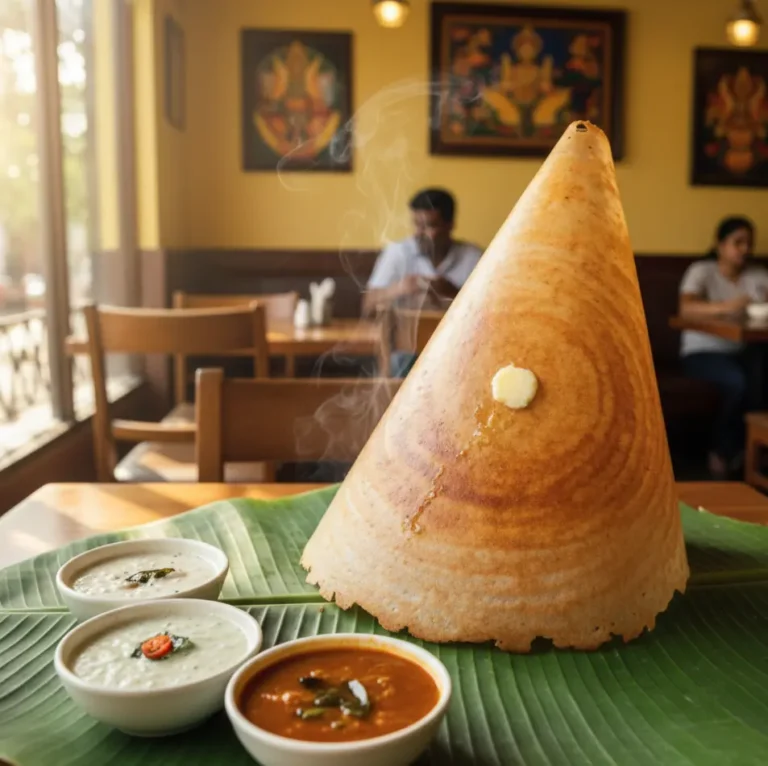What is an Indian Dosa?
An Indian dosa is a thin, crispy, and flavorful pancake prepared from fermented rice and urad dal. This classic South Indian dish is a well-liked one both nationally and internationally and is frequently eaten for breakfast or as a light dinner.
Made from a simple blend of rice and urad dal (black lentils), the dosa batter is fermented overnight, resulting in it having a naturally light, airy texture and a hint of tangy flavor. When ready, it is spread thin on a hot griddle (tava) and cooked until it is golden brown, crisp on the edges, and tender in the middle, resulting in the world-famous South Indian treat.

Is Indian Dosa Healthy?
In addition to being tasty, the Indian dosa is a nutritious, well-balanced meal. Made from urad dal and fermented rice, it is naturally high in fiber, protein, and other vital nutrients. Its light, crisp texture makes it easy on the stomach, and the fermentation process improves digestion and gut health. Dosa, when made with little oil and served with chutney and sambar, is the ideal combination of flavor, health, and tradition, demonstrating that eating well can be genuinely fulfilling.
What is an Indian Dosa Made Of?
A basic, healthful batter consisting of rice and urad dal (black gram lentils) is used to make Indian dosas. The ingredients are soaked, pounded, and fermented overnight, giving the dosa its unique light, airy texture and faintly acidic flavor.
Is Indian Dosa Gluten Free?
Yes, traditional Indian dosa is naturally gluten-free. Made primarily from rice and urad dal (black gram lentils), it includes no wheat or gluten-based ingredients, making it suitable for people with gluten intolerance or celiac disease. But it’s crucial to make sure the dosa is made in a hygienic, gluten-free setting, particularly in eateries where there could be cross-contamination with wheat-based items.
Is Dosa Healthier Than Pizza?
Yes, in general, traditional Indian dosa is healthier than pizza.
- Ingredients Matter: Dosa is cooked with fermented rice and urad dal, which provide protein, fiber, and important nutrients, whereas pizza frequently contains refined flour, cheese, and high-fat toppings.
- Lower in Calories and Fat: A plain or barely oiled dosa is lighter and simpler to digest than pizza, which can be high in calories and saturated fat.
- Gut-Friendly: Unlike pizza, dosas’ fermentation process promotes a healthy digestive system.
- Customizable for Nutrition: Dosa can be paired with sambar and chutney for a balanced, nutritious meal, whereas pizza is usually high in carbs and fat.
Is Dosa South or North Indian?
One traditional South Indian dish is dosa. Since ancient times, it has been a common breakfast or snack throughout southern India, particularly Tamil Nadu, Karnataka, Andhra Pradesh, and Kerala. Dosa is closely linked with South Indian cuisine, but it has gained popularity throughout India and internationally.
Is Dosa a Cheat Meal?
Traditionally prepared dosas are not a cheat meal. It is made from fermented rice and urad dal and is light, nutrient-dense, and easily digested. When combined with sambar and chutney, it offers a well-balanced combination of vital minerals, fiber, and protein. A plain dosa is a nutritious and complete meal that is ideal for daily consumption rather than a one-time treat, in contrast to traditional “cheat foods” that are heavy in refined flour, sugar, or bad fats.
Which Type of Dosa is Best?
The “best” type of dosa depends on your taste and health preferences.
- Plain Dosa: Classic and crispy, low in calories, and perfect for a healthy, light meal.
- Masala Dosa: Filled with spiced potatoes, it’s delicious and filling, but slightly higher in calories.
- Rava Dosa: Made from semolina, it’s extra crispy and quick to prepare — a great option if you love crunch.
- Set Dosa: Soft and fluffy, often served in portions of two or three — ideal for a lighter, protein-rich breakfast.
Is Dosa Good for Gut Health?
Dosa is great for gut health. Fermented rice and urad dal (black gram lentils) are used to make the batter, and the fermentation process creates healthy probiotics. These probiotics assist in maintaining a healthy balance of intestinal flora, improve digestion, and promote nutrient absorption.
Combining dosa with sambar and coconut chutney adds fiber and nutrients, making it not only tasty but also gentle on the stomach and beneficial to overall digestive health.
Which Dosa is Best for Weight Loss?
For weight loss, the healthiest dosa selections are ones that are light, lightly oiled, and high in protein and fiber.
- Plain Dosa: This traditional, crispy, thin dosa is minimal in calories and simple to digest. Serve it with sambar and coconut chutney for a well-balanced, substantial meal.
- Ragi or Millet Dosa: Made from finger millet or other whole grains, these dosas are rich in protein and fiber, which help you manage your weight and feel fuller for longer.
- Moong Dal Dosa: Made with split green gram, this dish is high in protein and low in carbohydrates, making it an excellent choice for a nutritious, weight-loss lunch.
What is the Best Time to Eat Dosa?
Dosas are best eaten in the morning for breakfast or as a light meal during the day.
- Breakfast: A freshly prepared dosa with sambar and chutney contains a healthy balance of carbohydrates, protein, and fiber, providing you with long-lasting energy to begin the day.
- Lunch or Light Dinner: A plain or lightly packed dosa can also be a nutritious, easy-to-digest meal in the afternoon or evening, particularly if you like lighter evenings.
How Many Dosa Can I Eat in a Day?
The quantity of dosas you can have in a day is determined by your dietary requirements, degree of activity, and general diet.
- For a balanced diet: 1-2 plain or lightly loaded dosas per meal are recommended. This provides enough energy without overeating carbs or calories.
- For active people: If you’re highly active or exercise frequently, you can add an extra dosa or two with protein-rich accompaniments such as sambar or daal.
- For weight control: Limit your intake to one dosa per meal and steer clear of heavy fillings or excessive oil to maintain a healthy, light weight.
Is Dosa Anti-Inflammatory?
Yes, traditional dosa can help reduce inflammation. The fermented batter of rice and urad dal contains probiotics, which promote gut health and reduce digestive inflammation. Reduced systemic inflammation in the body is strongly associated with a healthy gut microbiome.
Furthermore, when served with sambar (rich in lentils and spices like turmeric) and coconut chutney, dosa has natural anti-inflammatory effects due to fiber, antioxidants, and beneficial plant chemicals.
Can Diabetic People Eat Dosa?
Yes, diabetics can eat dosa as long as they take certain measures.
- Choose healthier options: Ragi, millet, or moong dal-based dosas are healthier than classic white rice dosas because they have a lower glycemic index and release sugar more slowly into the bloodstream.
- Keep an eye on portion size: Limit your intake to one or two dosas every meal to prevent blood sugar increases.
- Pair wisely: Combine dosa with sambar and coconut chutney instead of sugary or fried sides to keep the meal balanced.
- Limit Oil: Use as little oil as possible when cooking to cut down on excess fat and calories.
Is Dosa a Probiotic Food?
Traditional dosa is indeed a probiotic. Rice and urad dal, or black gram lentils, are combined to make the batter, which naturally ferments overnight. This fermentation process generates beneficial bacteria (probiotics), which serve to maintain a healthy gut microbiota, aid digestion, and increase nutrient absorption.
Dosa with sambar and coconut chutney adds flavor while also providing fiber and essential nutrients, resulting in a gut-friendly, wholesome meal.
Does Dosa Cause a Glucose Spike?
It depends on the type of dosa and portion size.
- Traditional white rice dosa: Prepared from white rice and urad dal, it has a low to high glycemic index, which can raise blood sugar levels, particularly when eaten in large quantities.
- Healthier alternatives: Dosas made with millets, ragi, or moong dal release sugar more slowly and are less likely to cause an unexpected glucose spike.
- Tips to reduce spikes: Serve the dosa with coconut chutney and fiber-rich sambar, use little oil, and serve in moderate quantities.
Final Thought
At Swad Restaurant, we deliver the best Indian food in Lethbridge to your table. Our menu includes all the varieties of dosas for the dosa lovers. From classic vegetarian dosas to spicy masala varieties, savory non-vegetarian options, and even fun kids’ dosas, there’s something for everyone to relish. Fresh ingredients and traditional methods are used to carefully make each dosa, guaranteeing a tasty and authentic taste with each bite. Whether you want a quick snack or a big meal, our extensive menu of dosas makes us the go-to place for Indian food in Lethbridge.
